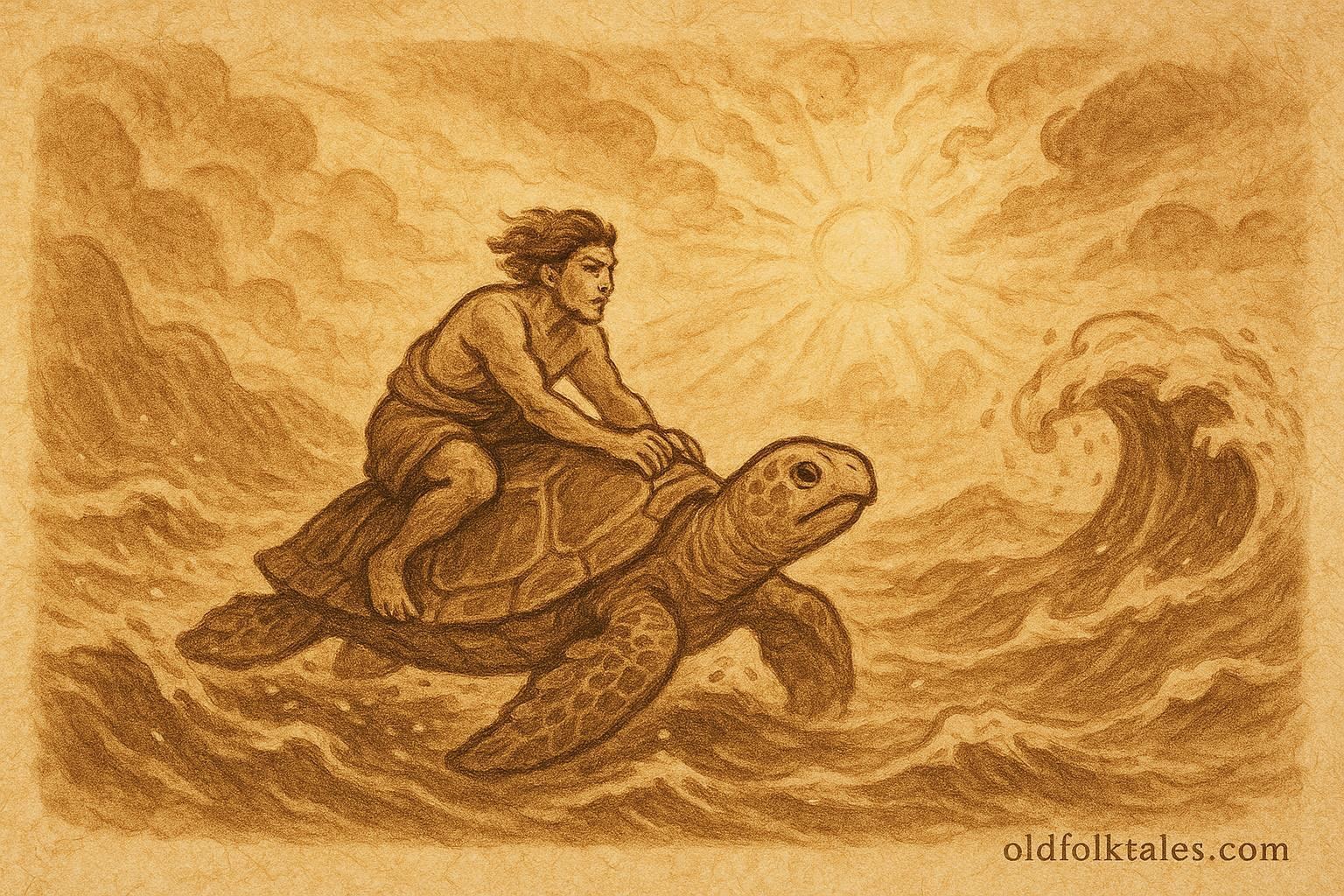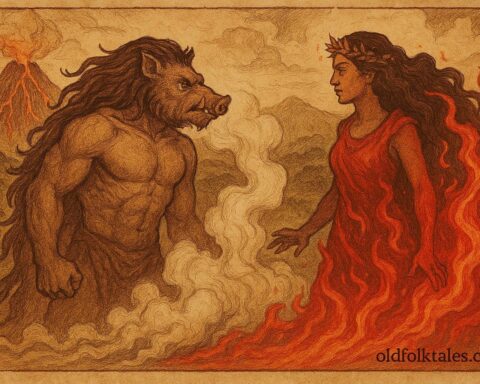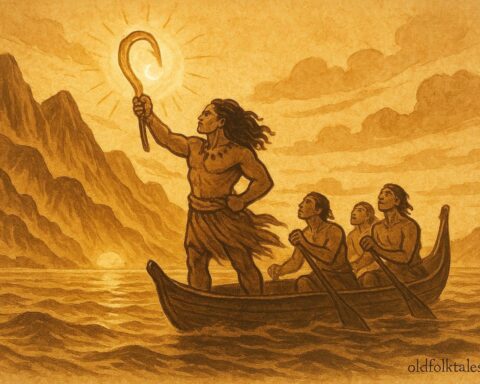Long ago, when the waves around Tonga were calm and the stars guided fishermen home, there lived a humble man named Latu. He was known throughout his small coastal village for his quiet heart and gentle ways. Every morning, before the first light of dawn, Latu would push his small canoe into the ocean, guided only by the rhythm of the tides and the songs of seabirds.
The sea was both his companion and his livelihood. Though his catches were modest, Latu always gave thanks to Tangaloa, god of the sea, and shared a portion of his fish with neighbors who had little. His humility made him beloved among the villagers, but it was his compassion that would one day bring him a blessing beyond measure.
One morning, as the mist still clung to the shore, Latu heard a strange thrashing sound near a reef. When he paddled closer, he saw a large sea turtle caught in a tangled fishing net. Its flippers were bound tight, and its great shell was scratched from struggling against coral. The creature’s dark eyes met his with a look of exhaustion and quiet pleading.
Moved with pity, Latu climbed from his canoe and began to untangle the net, even as sharp coral cut his hands. “Be still, friend,” he whispered. “You are not mine to take.” With great care, he freed the turtle and watched as it slowly drifted back into deeper water. For a moment it lingered beside his canoe, circling once, before diving beneath the waves.
That night, as the moon rose over the sea, Latu felt a quiet peace. He believed that in freeing the turtle, he had done only what was right. He spoke of it to no one and soon forgot the event. But the ocean, vast and alive with spirits, never forgets an act of kindness.
The Storm and the Miracle
Months passed. One fateful evening, a fierce storm swept across the island. Winds howled like spirits of anger, and the sea rose in towering waves that shattered canoes and tore palm trees from the shore. Latu, who had gone fishing that morning, struggled to return as lightning split the sky. His canoe was tossed like a leaf. The mast snapped, his paddle broke. Soon he was swallowed by the dark waters and swept far from land.
For two days and nights, Latu drifted on a piece of wreckage, his body weak and his hope fading. He prayed to Tangaloa and to the spirits of his ancestors to guide him home. Then, as the first light of dawn glimmered through the clouds, he felt a gentle nudge beneath him.
Through blurred eyes, he saw the unmistakable shape of a great sea turtle, the very one he had freed long ago. It rose from the depths beside him, its eyes calm and knowing. Slowly, the turtle lifted Latu onto its broad shell and began to swim.
Hours passed as the creature glided steadily through the sea, cutting through waves with powerful grace. Latu, though weary, felt a strange warmth, as if he were carried not just by an animal, but by the living spirit of the ocean itself. By sunset, the coastline of Tonga shimmered in the distance. When at last the turtle reached the shallows, it paused and turned toward him. Latu pressed his hand gently against its shell. “Thank you, old friend,” he whispered. The turtle gazed at him for a moment longer, then disappeared beneath the waves.
The Legacy of Respect
When Latu returned to his village, the people rejoiced. They believed he had been lost to the storm and mourned his passing. He told them of the turtle that had saved him, and the elders declared it a sacred sign, proof that kindness to nature brings blessings from the gods.
From that day on, the people of Latu’s island made a vow: never again would they harm a turtle. Whenever one was caught in nets or found resting on the beach, it was freed with reverence and offered a prayer of thanks.
The villagers built a small stone shrine near the shore to honor the spirit of the turtle. Fishermen left offerings of coconut oil and flowers before setting out to sea, asking for safe passage and fruitful waters. The story of Latu’s rescue became part of Tongan teaching, passed from generation to generation, a reminder that the ocean watches over those who show compassion to its creatures.
And so, under the stars that guided his canoe, Latu lived the rest of his days in gratitude. He continued to fish with care, never taking more than he needed, always whispering a blessing to the waves.
To this day, when turtles glide near the reefs of Tonga, elders tell their grandchildren:
“Perhaps that is Latu’s turtle, still watching, still remembering.”
Moral of the Story
The tale of The Turtle and the Fisherman teaches that every act of kindness, no matter how small, returns to us in ways we cannot foresee. To respect nature is to honor the gods, and those who show compassion will find that the ocean itself remembers their goodness.
Knowledge Check (Q&A)
- Who are the main characters in The Turtle and the Fisherman?
The story centers on Latu, a humble fisherman, and a sea turtle he once saved, both symbolizing compassion and reciprocity in Tongan folklore. - What is the main moral lesson of this Tongan folktale?
The story teaches that kindness to nature and its creatures brings blessings, reflecting the Tongan belief in balance between humans and the ocean. - What does the turtle represent in Tongan mythology?
The turtle symbolizes wisdom, protection, and the spiritual connection between people and the sea. - How did the fisherman show respect for nature?
Latu freed the trapped turtle and later honored it through prayer, teaching his village to protect sea life. - Why is the story culturally significant in Tonga?
It embodies Polynesian values of gratitude, respect, and harmony with nature, key elements in Tongan tradition. - How does The Turtle and the Fisherman explain Tongan beliefs about the ocean?
It reflects the belief that the sea is alive with divine presence and that good deeds within it never go unnoticed by the gods.
Source: Adapted from Folk Tales from Polynesia by Johannes C. Andersen (1928) and earlier Tongan oral traditions.
Cultural Origin: Tonga












